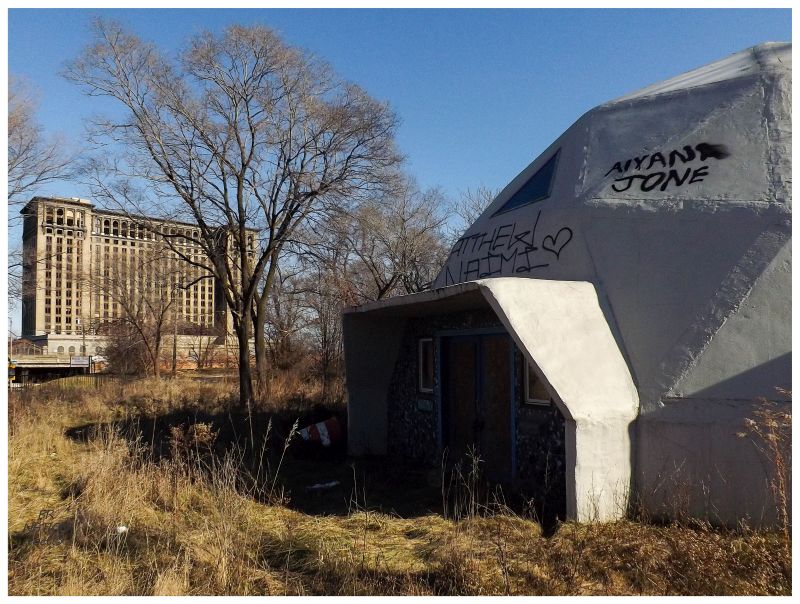
It was once again time for that annual tradition of Christmastime Detroit for a day or two with Steve and Donnie. Not long after crossing the border, actually all of 30 seconds after, we decided to finally check out the geodesic dome houses by the train station. This is after years of Donnie asking me what was going on with them. After all, they've been an everlasting sight since we started to check out the city years ago. It also has to do with the proximity to the bridge. When you exit the Ambassador Bridge you have three options if you're not taking the interstate & we often take the right turn towards these domes; and even if we go left to Mexicantown, we return past the domes to head downtown or to the eastside or wherever later. |
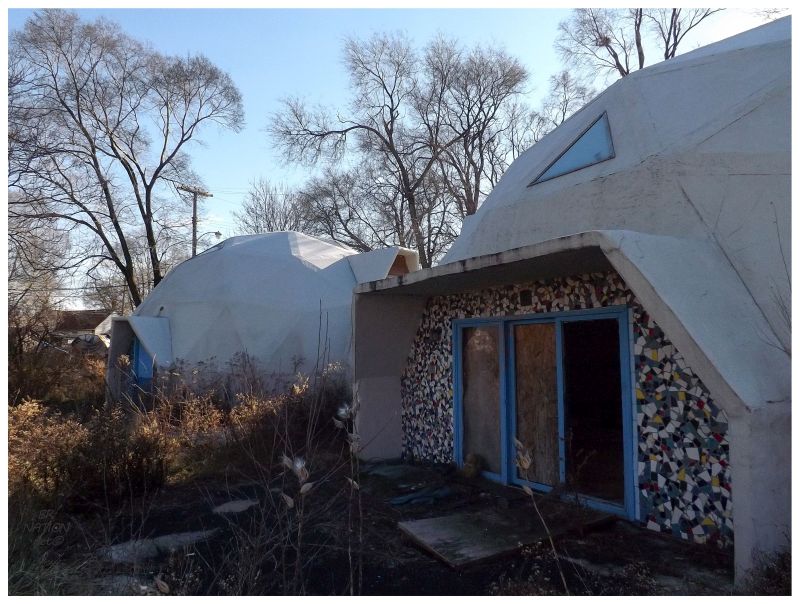
For how much I can sit around and reminisce about the places lost around Southwest Detroit & Delray, the geodesic domes of Leo Gillis have remained here alongside the point where Vernor dips downward under the train station's rail lines. Groundbreaking for the domes would occur on the day Hudson's was demolished (October 24, 1998) and the Metro Times newspaper states that the dome pieces were ordered and put together in the year 2000. This recent construction & the strange, large size of the lot made me wonder about what was here before the domes. Looking at old aerial photographs, it looks like there were simply more houses back then, presumably similar to the ones still standing on the south end of the lot along Chipman St. |
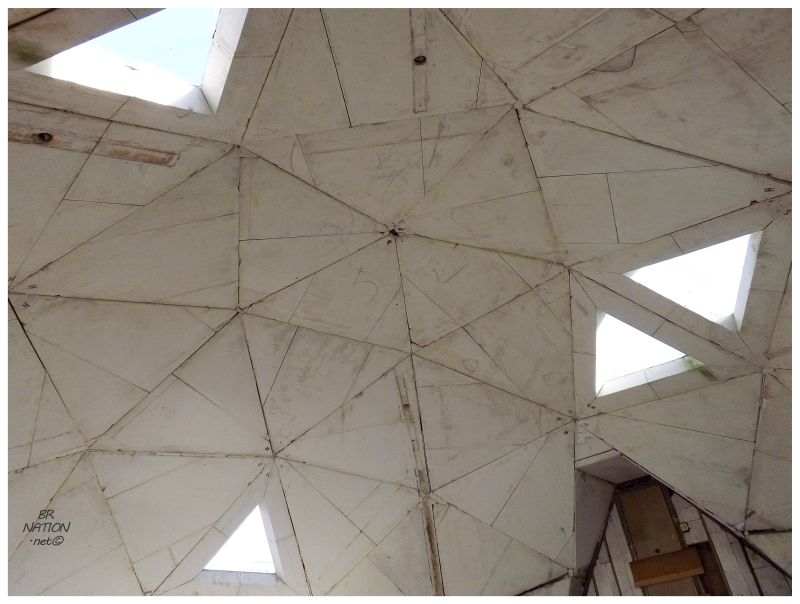
The two domes were constructed by ordering a package from American Ingenuity Co. for $20,000. Friends, volunteers & Gillis, all of whom mostly had little-to-no construction experience, put together the metal-reinforced concrete pieces to form the house and garage. If you look closely at the above picture, you'll notice matching letters where certain triangles meet - user-friendly labels to help with dome assembly? Exploring an unconventional home like this makes you ponder whether you could live here. While I liked the location and the possibility of being able to build ramps inside, I think the maintenance & having to deal with expensive, specialized repairmen would push me away. Also I don't know if I'd really want to be the "oddball" who lives in the dome house (even though I say that while I would live in a lighthouse or an A-frame house...) |
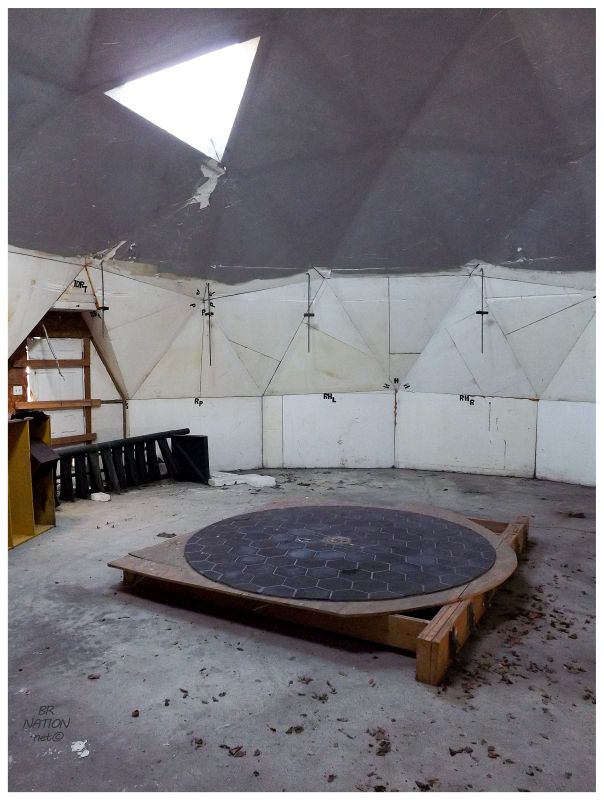
Gillis lived here with his wife Parkii and their two children. It's Parkii's glass and tile mosaics that flank the front doors, while local Pewabic pottery used to state "Celebrating 300 years of life in Detroit." above the doorway. Once inside, prior to stripping everything down, you would have walked into a room of "glittery stars, blue candles, cobalt and slate tile with a long steel dining table." There was also a kitchen with a floor made of 2x2-ft pieces of marble salvaged from the nearby train station; with a gold, brown and red family room located beyond. The remainder of the dome was filled out with a loft, where you'd find the purple master bedroom and green master bath. The secondary dome was the garage and recording space for Gillis' band Catalyst. (It seems that an interest in music ran in the Gillis family - his brother is Jack White of White Stripes fame). |
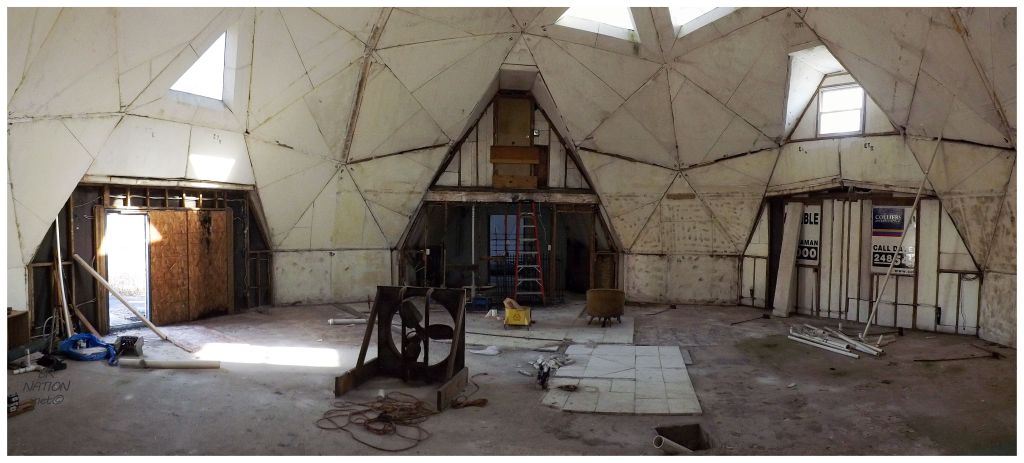
For all of the work & love put into the domes, the Gillises didn't live in them for long as they divorced sometime in the late 2000s. The house was used as an after-hours club/hangout for a while after that, but two men coming in with shotguns and one of them being killed inside put an end to that. The domes have since been sold to local fans of the geodesic design, but it didn't seem like much was happening in terms of renovation during our visit. I suppose they painted the domes white instead of sky blue sometime in ~2012 & the August 2015 Street View shows the grass trimmed. |
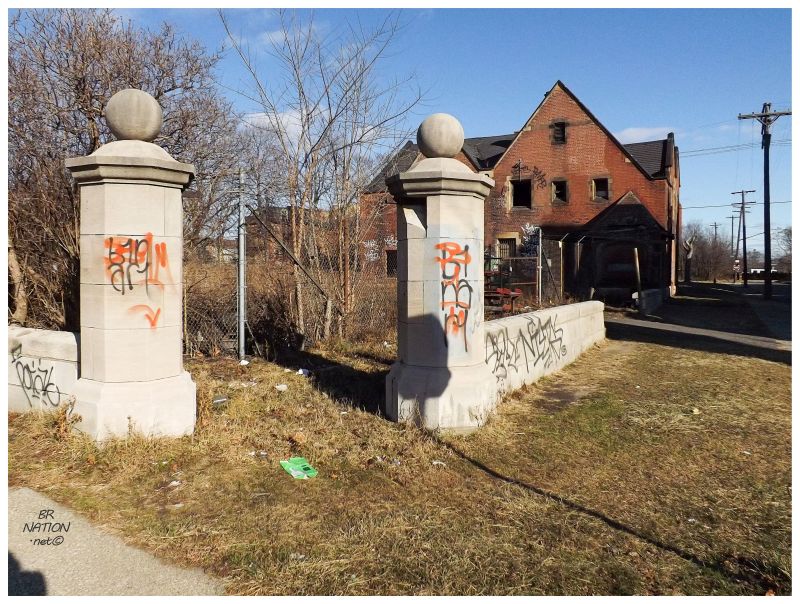
Shorpy has a picture from the 1900s of this stone wall that you should look at.
We'd go up Trumbull, turning at The Corner where now nothing but a metal fence and foul pole remain. At Grand River, Donnie was interested with a rundown church, while I was interested with this old arrangement of red bricks that I've always kept an eye on. Surprisingly, for a sunny day that was a few degrees above freezing, we found that there weren't any neighbourhood characters around as we exited the car. Now sure this peaked structure is pleasant enough, but the real reason it held my interest all these years is because it was the carriage house for the old Scripps Mansion. (I've also seen it called the Scripps House, as it wasn't over the top opulent like so many other Detroit abodes.) |
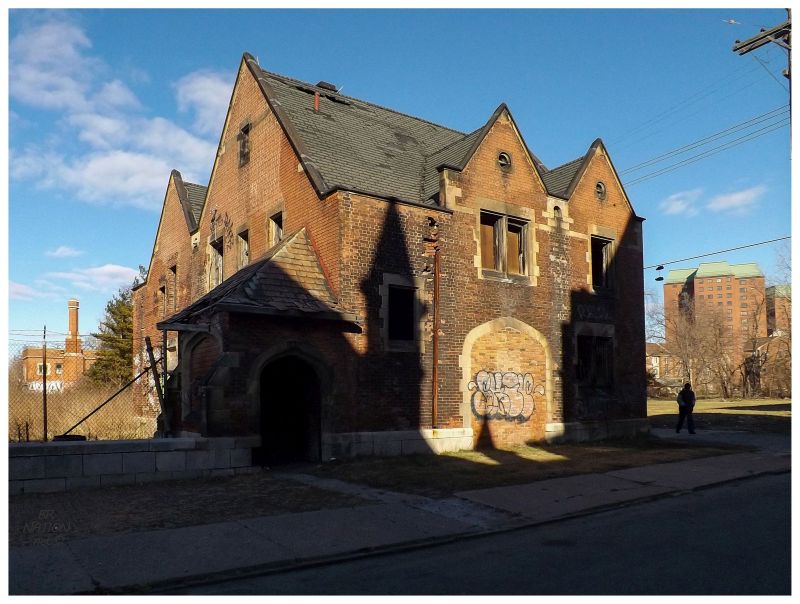
The Scripps Mansion itself burned down in a suspicious fire in 1986. This carriage house leftover would allow me to see part of a mansion that burned down long before I was able to come over here. It was like finding a foundation that still has cavities and small rooms where you can climb down, while the supported building has been gone for years. A special treasure of being able to glimpse something that you weren't even around to miss the boat on. While it would have been endearing to enter the carriage house through the arched passageway in the problematic shadow, two of us climbed that short wall instead, not realizing you could walk through until the group's third found the easier way. |
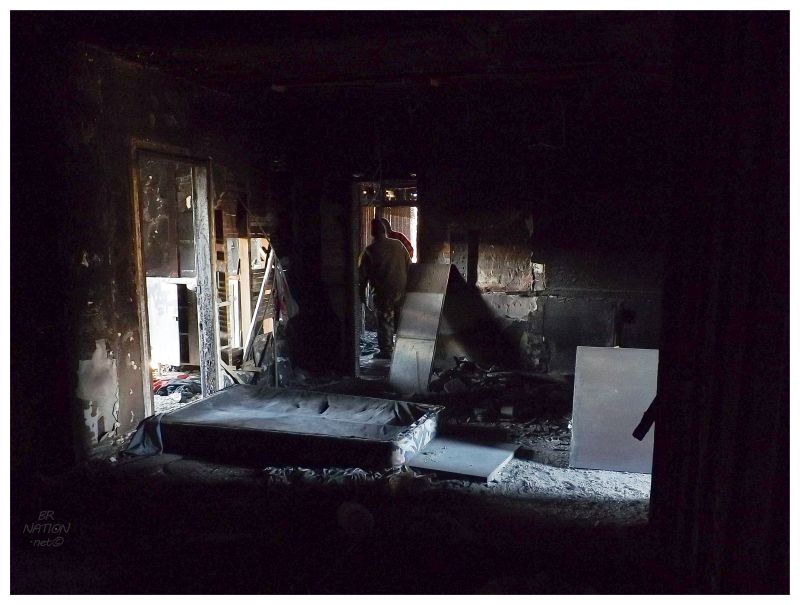
Inside, there were only a few areas not black with fire damage. The homeless seemed to have their mattresses in most of these somewhat clear areas, while areas of missing walls and burnt planks reinforced the carriage house's age. |
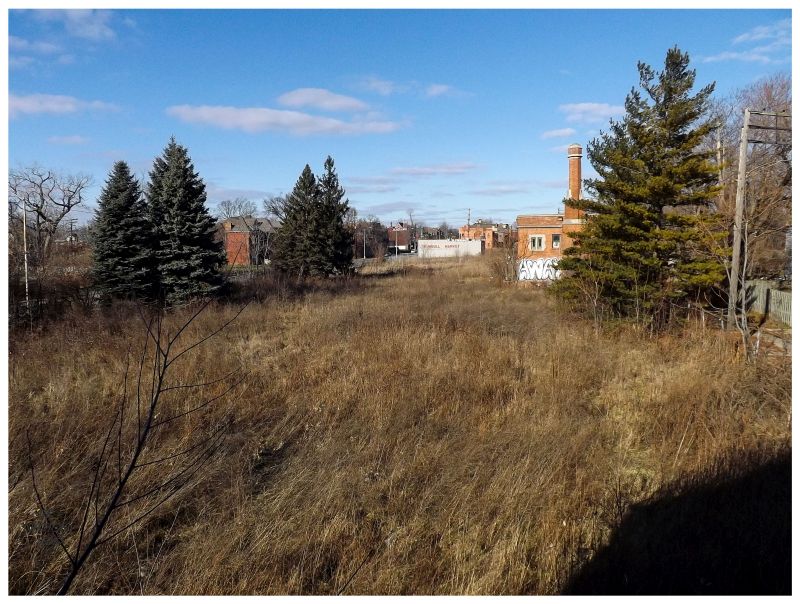
My favourite part was the view out over the overgrown lot towards what looked like the powerhouse, flanked by Michigan spruce & fir. Steve & Donnie were off questioning the stability of the staircase while I stood in this window, feeling like I was more in the Upper Peninsula than at Trumbull & Grand River. |

The view towards Trumbull Ave United Presbyterian/The Pilgrim Church wasn't half bad either - even if it was backlit for photographs. I've long admired this Venetian Gothic beauty on my frequent drive-bys and being able to take in an elevated view wasn't half bad. Unfortunately I won't ever have this view again, because this carriage house burned in a sizable fire one night in March of 2016. I drove by shortly after & it wasn't yet demolished, but a fire of that size might have put it on the public safety priority demolition list. As always, it was good to be prudent by taking the time to check it out. |

Since we were in the neighbourhood, Donnie stopped at the nearby do-it-yourself (DIY) skatepark. I was pretty excited about the two flat rails in a row, but really, I would ride everything here & die to have it near me. The people behind this park have done an amazing job and I hope to ride here one of these years. |
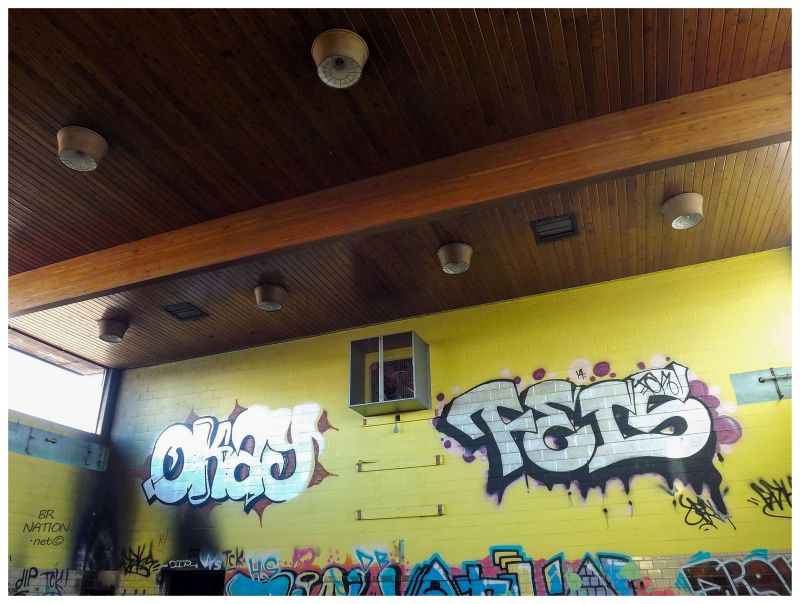
The homemade skatepark is built on the basketball and tennis courts of the old Wigle Recreation Center at Selden & the Lodge Service Drive. With a wide open recreation center right next to the unsanctioned skatepark, I of course had to check out the inviting building, taking time to photograph a place that might not get as much respect as the countless other schools and rec centers in this city. The skatepark would almost get torn down because of this Wigle Recreation Center being on the demolition list. The City of Detroit saw this entire parcel as land they needed to clear to put on the market, but thankfully after the skateboarder/bmxer uproar, they decided to only demolish the old rec center; avoiding the cinder blocks and angle iron that make up the homemade skatepark. Of course I have my allegiances to skateparks, but putting that aside, I'd say in the end this skatepark helps with neighbourhood vibrancy and safety much more than the couple of vinyl siding townhouses they would have put here. |

After the DIY skatepark, we happened to drive by this church where I knew a way inside. |

...allowing Steve to take some selfies.
|
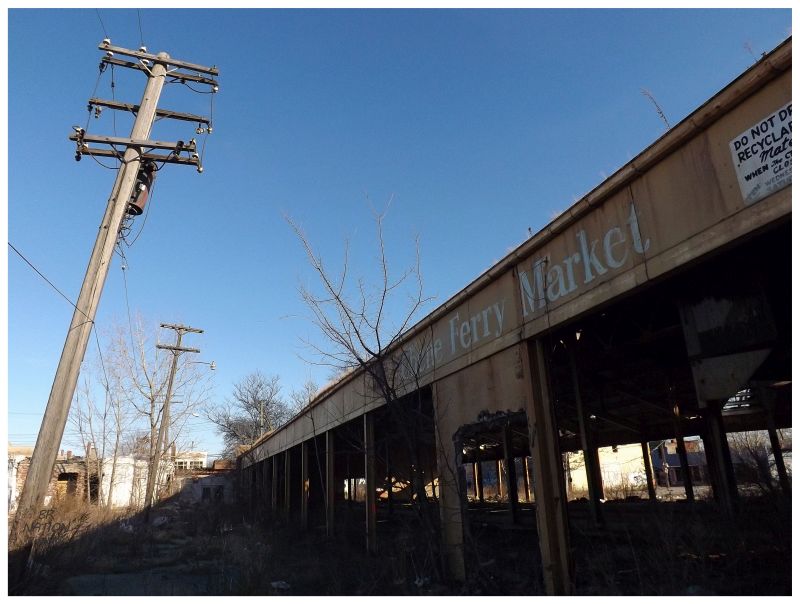
Next up was the Chene Ferry Market, which I've been meaning to stop by for a while, but an abandoned farmers market isn't all that exciting (but yet again, this is a place I've passed countless times, so I wanted some pictures before the metal beams start to disappear like the old sliding metal doors.) The Chene Ferry Market was built in the 1920s, joining two other municipal markets of the time (Eastern & Western Market). While you likely know Eastern Market because it's still around and popular, Western Market disappeared when the two were merged. Western Market was located near the site of Tiger Stadium and its merging into Eastern Market meant additional shed buildings being constructed there in the 1920s. |

Chene Street used to be the street to go down in Detroit to see an unbelievable line of unending, decimated buildings. Recently more & more of these buildings have fallen to arson and/or demolition, but in the mid-2000s, driving down Chene was like taking a portal into a Hollywood portrayal of the bad part of town. Of course many of the streets outside downtown have suffered simply from the economy, but Chene Street had extra help in the construction of the nearby odorous trash incinerator & GM's Poletown Assembly. The GM plant contributed to the destruction of the healthy Polish neighbourhood through division and eminent domain of houses, stores & churches. It was sometime in the 1980s that Chene Ferry would close as a market, becoming a recycling center until its closure in the 1990s. Nailhed goes into much greater detail with much better pictures, including the handsome front of this building that I forgot to photograph. Amazingly there are future plans for this property. Mayor Mike Duggan announced in October of 2015 that the property and other nearby parcels would be leased-to-own'ed to RecoveryPARK, a group who plans to farm the land while hiring those with criminal records, addictions or low literacy rates. The historic Chene Ferry Market shed is to be maintained as part of this plan! |
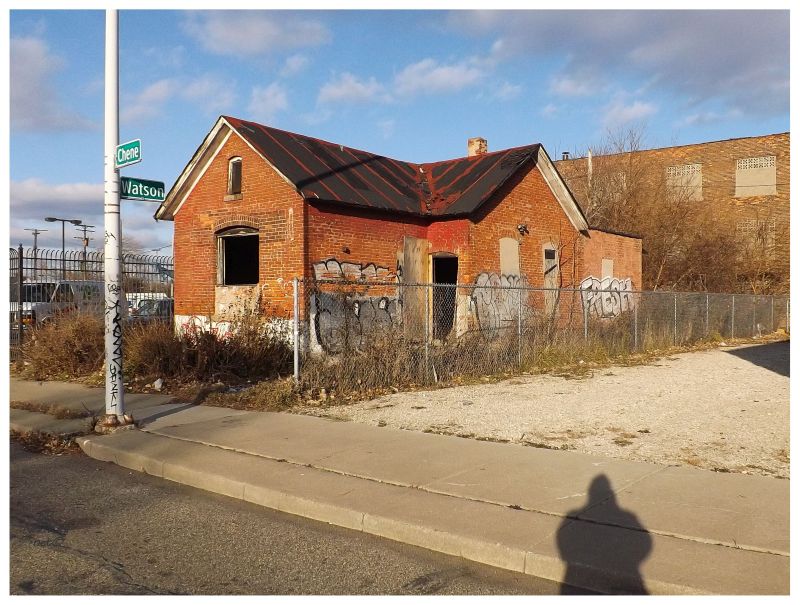
Next up was a stop at Zeidman's Pawn & Jewellery Discounter, a jewellery store of flashy watches & necklaces that's not in the best neighbourhood. My friends were excited to finally see what was behind the tan cinder block wall along Gratiot, while I was excited to grab a 40 at the nearby Motor City Market Liquor. Stashing the bottle in the wide pocket of my frayed ice fishing jacket, I couldn't help but then photograph this leftover house shoehorned between a UPS parking lot and some forgettable one-story garage. Walking through, I found the house was much nicer on the outside, with an interior of wood paneling and about a foot of garbage beneath my shoes. |

I've always been intrigued by the 3-story, aged factory behind Zeidman's, so I took the opportunity to finally check it out while we were in the area. A hand-painted sign on the side shows that this factory was A&A Plating at one time & I liked the interior with its wood floors and repeating beams, but the harsh light left me looking out over the empty prairie to the north instead. |
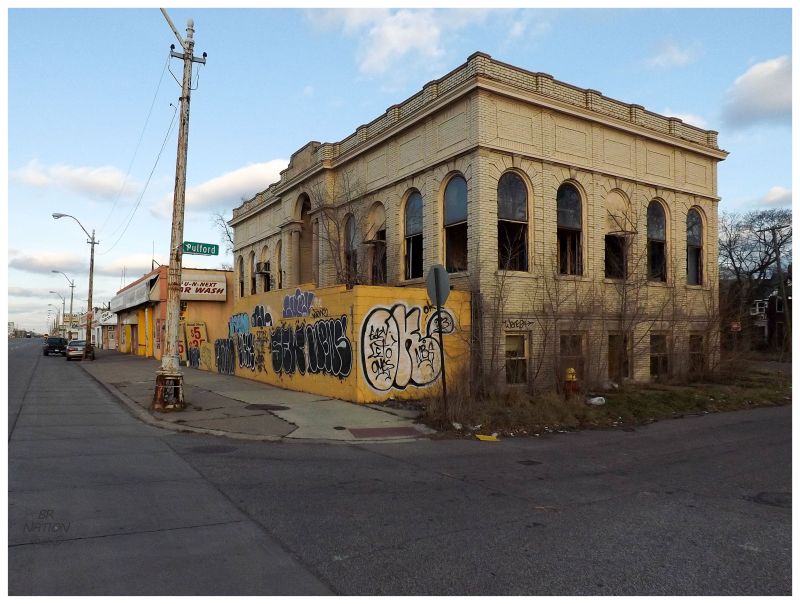
We drove back down Gratiot having noticed and remembered the Hosmer Branch Library while on our way up to Zeidman's. I always noticed this building because of the monstrosity of a wheelchair ramp they have outside, craning my neck trying to see if there were any bike riding possibilities. In recent years the building seemed to be going downhill, but it was one of those things where you're unsure if it's abandoned or just rundown. Today it was suddenly quite obvious. Department of Human Services pamphlets were strewn about inside, a product of the Hosmer Branch later becoming a place for those with drug addictions, HIV and methadone needs. The papers weren't yet damp enough to imagine this building being wide open more than a few years, and Google StreetView shows all of the windows intact and graffiti cleaned off in July of 2013. StreetView also shows the Department of Human Services banner disappearing sometime between June 2009 and June 2011. |

The Hosmer Branch Library started out at Pulford Street's Harris High School on April 16, 1900 (Pulford is the side street where the library is located.) The library would move to a different building on Gratiot Ave in 1903, then to the Louis Kamper-designed structure you see in these pictures on January 7, 1911. |
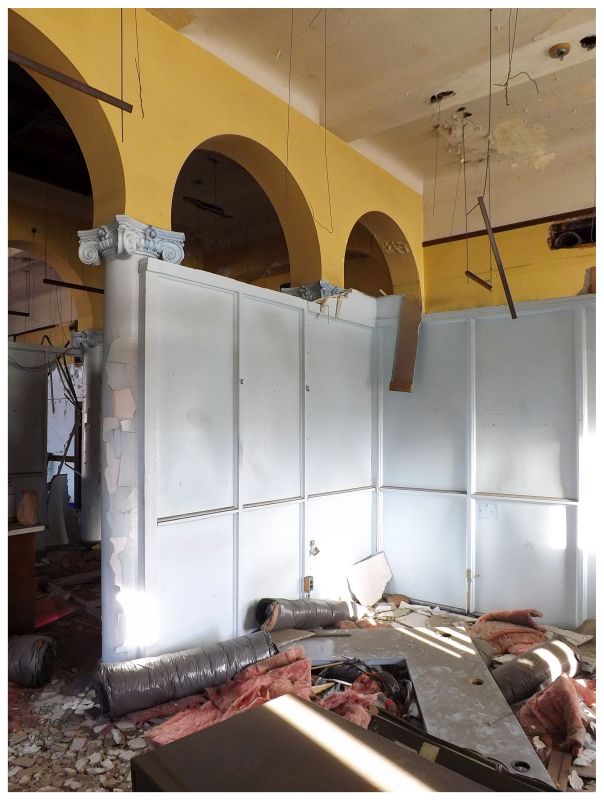
I guess ever since I worked hard to get into the Lothrop Branch Library over on W Grand & Warren to only found an empty shell, I've sort of scoffed at other libraries and expected the same thing (even though I clearly don't make sense because Mark Twain Library was a sight to behold). It's with thoughts of Lothrop instead of Twain that I stepped into Hosmer and was taken aback with the archways interrupted with Ionic columns. Even though the health services organization had put up drop ceilings and cheap walls, this entryway made the whole Hosmer stop worthwhile. The three of us would relax beside a convenient table here in the main hallway & later when I'd return on another trip, my group again did much of the same (although Nailhed put in work in terms of moving around and taking good handheld pictures at night). |

"Hosmer Branch - Reading Room." Photographer: C.C. Brewe

As it had been a while since Hosmer had been used as a library, nothing remained in terms of book shelves, books or card catalogues. |
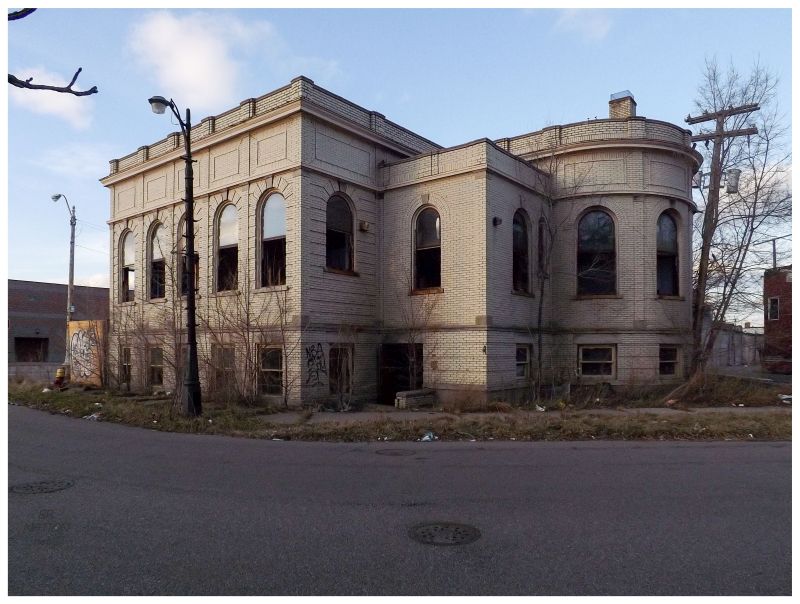
With an active car wash right beside the library, we parked on the backside Pulford Street and noticed the large apse to the back of the library for the first time. |
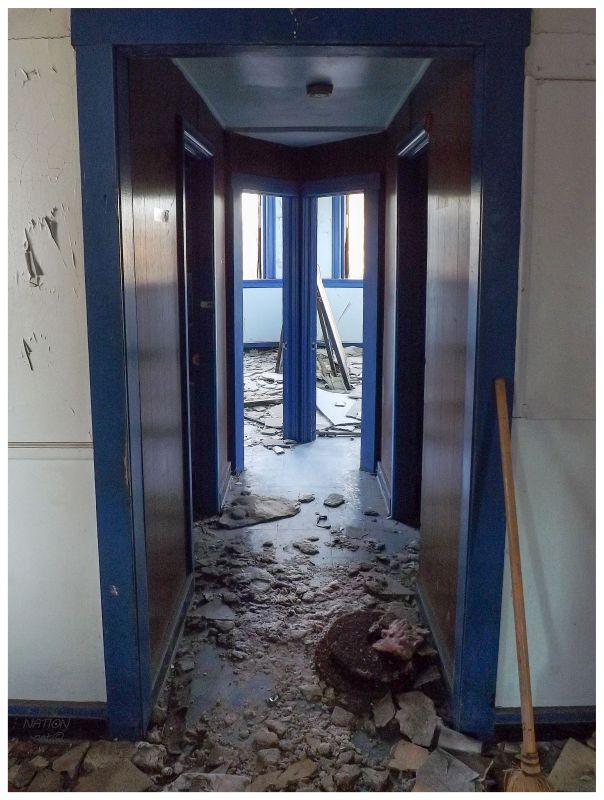
Inside, the circular room was subdivided into two offices instead of one glorious rounded office. The old floor layout for Hosmer shows that this was the stack room, with the two big rooms out front both being reading rooms. Rounded tables and pulled-up seats were in the middle of this stack room, and looking at the old photo, it looks like the hallway I saw above was only created with drywall and plywood. The stack room opening was originally as wide as the entryway, with shelved books on each side until they meet in a rounded end. Unfortunately an April 2016 fire means that these walls will never fail and give a glimpse back to the wide entryway. By the looks of the picture Donnie sent me, it sadly doesn't look like much remains to the interior of Hosmer besides a charred, unsafe floor. |
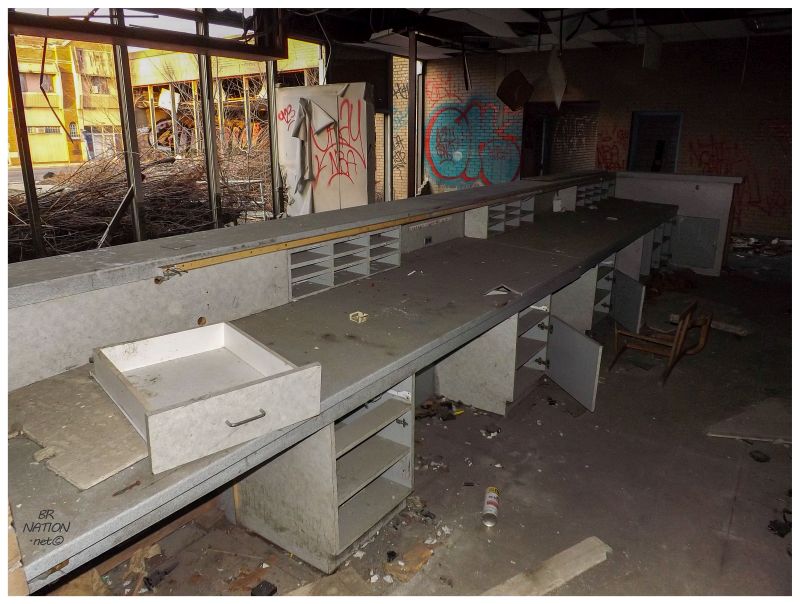
The front desk.
The old Detroit Police 7th Precinct is only a stone's throw from Hosmer. |

I'd been inside this building before, back when it was much harder to get inside than today. This must've been about 7 or 8 years ago now, when we were rolling much deeper with close to 10 people checking out the scene. We spent a lot of time down in this cell area & even crammed into the cells, something that sticks in my mind after all these years. I always wondered about coming back here, thinking about old folks who I've grown apart from and who I haven't seen in years; as well as other people I see here & there but not nearly enough. |

Leaving the row of cells, the holding area was only illuminated by tiny, tree-covered windows. Back in the day, even the people with weak flashlights couldn't see everything they wanted to see in this area. |
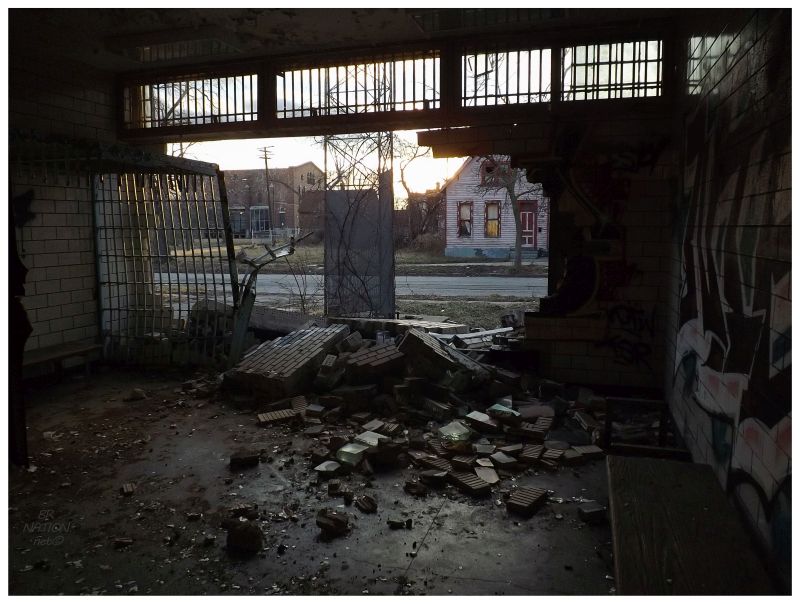
Lack of light isn't a problem anymore as car thieves or scrappers took out the whole streetside wall! Seeing as many of the cell bars were scrapped for metal, maybe the metal thieves took out this wall? Then again that seems like a lot of work for some steel jail bars. I'm going to say scrappers only took out this wall if there was something larger and more valuable inside. And if not, my money would be on a car thief losing control or a drunk driver. The September of 2013 Google Street View shows the wall intact, so it remains another good ole' Detroit mystery. |
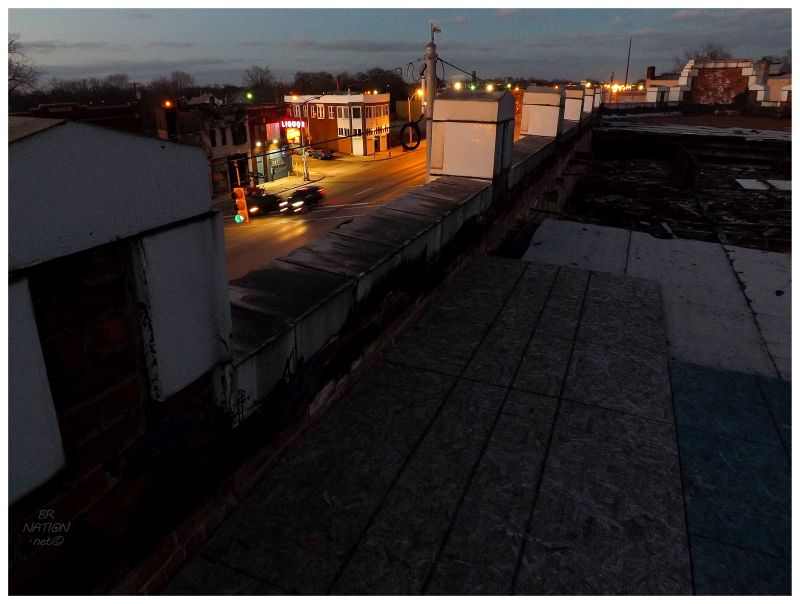
We moved to a nearby commercial building after grabbing some old, glass bottle Steel Reserve 40's. Thankfully we knew some Steel Reserves still lingered in the dusty bottom of one liquor store's grimy cooler, helping us avoid drinking from the plastic 40s that Miller-Coors Beverage Corp has now rolled out on everyone. The sun had just set & the sparse lights of this corner came to life. It's here that I thought about how downtown, midtown & Corktown might be on the rise & very different from 2005, but areas like this are even more barren. In just this tiny 100 or 200 meter long area, we had explored a former neighbourhood library turned health clinic, police precinct and now this commercial building where 4 or 5 businesses had packed up and left. Certain areas aren't coming back so quickly or at all, and are suffering a cataclysmic blow instead. The 7th Precinct Police Station was torn down in early 2015. Anyway, we'd bullshit up here about this, then move on to whatever friendly chatter before going on our way into the night. Another day in Detroit that was good in terms of being productive in taking pictures of endangered buildings - although laying off the 40s would've definitely have helped their composition/lighting - but also hanging out and enjoying the company of good friends. |